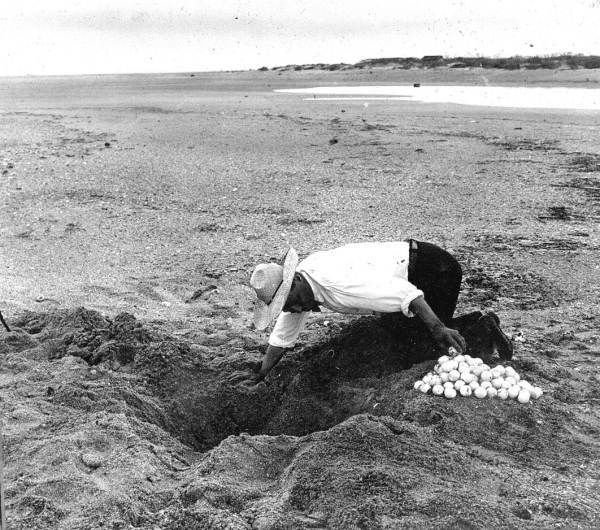Early Southwest Florida Settlers Feasted on Sea Turtles

An early settler removes loggerhead sea turtle eggs.
Image: Florida State Archives
Sea turtle nesting season began on May 1, and scientists are predicting a record number of endangered loggerhead and green sea turtles will clamber out of the Gulf of Mexico and lay their eggs on local beaches. Last year, Mote Marine Laboratory and Aquarium monitored some 4,400 nests between Longboat Key and Venice, and officials ask residents to do everything they can to protect them, from keeping beaches dark at night to avoiding the yellow-taped nests.
Those 4,400 nests sound like a lot to present-day Southwest Floridians, but back in 1900, many times that number dotted area beaches. Early settlers told stories about seas and beaches that teemed with life. One man recalled you could almost walk across the bay on the backs of fish, and in 1955, Englewood’s Ferdinand Gottfried told the local newspaper he remembered rowing out and filling his 16-foot boat with so many mullet he had to stand up to paddle home. In The History of Englewood, a 1976 collection of columns by Englewood reporter Josephine O. Cortes, Isabel Hanlon describes how in the early 1900s her family feasted on sea turtle meat all through the nesting season.
On summer nights when it was too hot to sleep, Hanlon’s father would often walk up a mile-and-a-half stretch of beach close to their house, looking for turtles as they emerged from the water and flipping them over so they couldn’t move. Most nights he would kill from one to three turtles, and in the morning he would return with buckets hanging from a yoke and make several trips home with the meat. It was a full day’s work for the family to butcher and clean the meat, which would be soaked in several changes of salt brine and stored in covered tubs. Almost every bit of the turtle was used, from the heart and liver—considered delicacies—to the flippers, which were pickled in vinegar, onions and spices. Even the fat was rendered out. Between turtle meat and mullet, said Hanlon, their “main food items” were provided at all times, “the only cost being a few pennies for spices and salt.”
Even in those days, Hanlon’s father was conservation-minded. He waited until the turtles laid their eggs to capture them. But Hanlon says raccoons would dig up and devour many of them and people would row their boats over from the mainland to collect the eggs and eat them.
Turtle season runs from May 1 through Oct. 31; to learn more about Mote’s preservation efforts or to help, click here.



